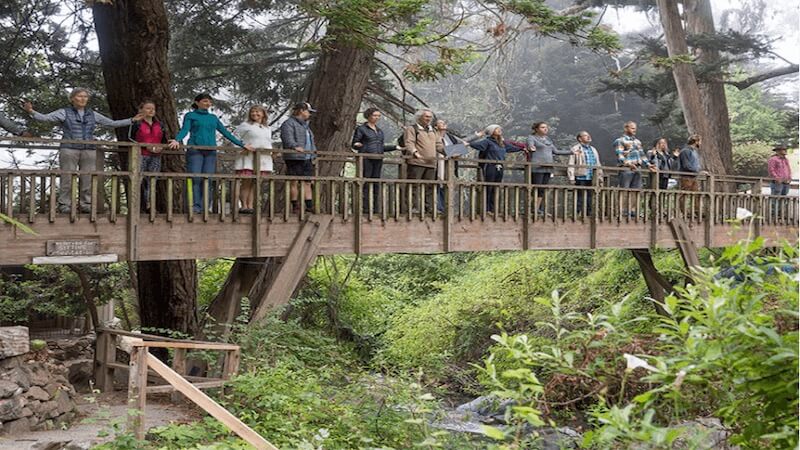
Throughout history, bridges have connected two points and often served as a symbolic marker. A journey from here to there; a time to reflect along the way. This month, as Esalen unveils a new bridge connecting the north and south side of campus, faculty and staff reflect upon what bridges mean to them, the transformational process of creating a new bridge and the positive ripple effects the new structure will create.
Beloved Esalen faculty Chungliang Al Huang, a longtime tai chi teacher and the founder and president of the Living Tao Foundation, has a deep connection to the existing creek footbridge. He has crossed the bridge and meditated underneath it along the running brook for more than a half a century.
“Since I first came to teach here, that sacred place at the bridge represented my life’s work in bridging East/West cultural arts and finding a synthesis of the world’s yin/yang ‘tai ji’ unity,” Al says. “From the early days when Esalen co-founder Dick Price and I shared our kinship of being the perennial students immersed in the Tao, we treaded the path under that special bridge into the ravine and canyon hundreds of times together. It holds significant meaning for me.”
The current bridge was built in the mid-1980s. The genesis of the new bridge emerged as a way to create better access for all between the two sides of the Esalen campus, which a fresh water creek bisects. “The current bridge was at the end of its usable life," says Esalen Special Projects Manager Bruce Christiansen. "While the bridge may have meet the safety standards of the time it was built, there was room for improvement."
The new bridge features a variety of improvements, including:
From groundbreaking to completion, the construction process took approximately six months. Staff worked with a biologist throughout the bridge’s planning and execution, taking into consideration any and all environmental concerns.
The end result features a 50-foot span across the creek that is 12 feet wide with improved approaches and drainage on both sides. The structure contains a composite beam design consisting of steel I-beams with a reinforced concrete deck and a wooden and metal railing. Material from the old bridge will be distributed throughout the greater community.
"I see the symbolism in the new bridge as we're building a bridge between the old and the new, the past and the future," Bruce says.
"The old foot bridge carried a great many feet, human and beast, and provided as many intimate moments as those feet moved past each other," adds Tim Hulls, Esalen’s Director of Facilities. "The new bridge is a major milestone toward progress and what we at Esalen need to do to provide an experience that is inclusive, safe and a movement to sustainable practices."
Over the decades, many seminarians have experienced the Esalen bridge and have appreciated its placement on campus, including staff who have worked on property for many years.
"For me, the bridge always symbolized 'connection' as it connects both sides of the campus," says Tatyana Sanikovich, Esalen's Director of Human Resources. "I was taught a ritual while crossing the bridge that I enjoy. I was taught to stand on the bridge over the creek while facing the ocean. Next, you close your eyes and think of everything that you want to let go of that does not serve you, and you release it down the stream to the ocean. Then you turn to the canyon and think of everything you want to invite into your life and voice it internally or speak it out loud. As you face the river it will flow into you and your life. And then I would cross the bridge whichever direction I needed to go."
Al echoes Tatyana's sentiments, noting that the bridge evokes a sense of wonder as he recalls many individuals associated with Esalen who have made a difference in his life.
"I think of the bridge — the crossing and coming together of two sides of Esalen — to be my kinship and fortuitous collaborations with Esalen mentors, such as Alan W. Watts, Joseph Campbell, Gregory Bateson, Laura Huxley [wife of Aldous Huxley], Stanislav Grof and Huston Smith,” Al says. “It has been my good fortune to be an integral part of the Esalen family and to continue sharing my belief of this world unity with the importance of East/West cultural arts synthesis. Jointly, we will prevail and wake up the world to realize this 'human potentiality' of peace on Earth through this blessed experience of a utopian living community—Esalen— in which we are blessed to belong and to thrive.”
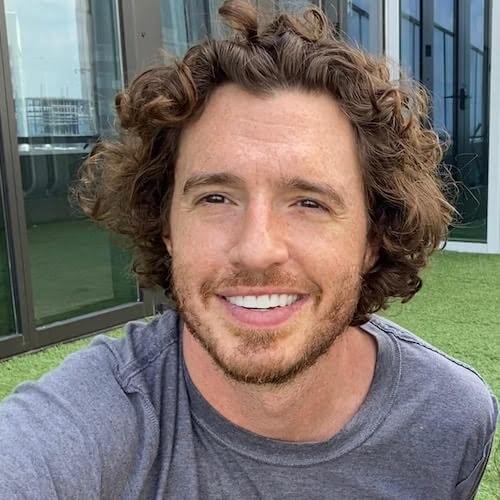
“Remembering to be as self compassionate as I can and praying to the divine that we're all a part of.”
–Aaron
“Prayer, reading, meditation, walking.”
–Karen
“Erratically — which is an ongoing stream of practice to find peace.”
–Charles
“Try on a daily basis to be kind to myself and to realize that making mistakes is a part of the human condition. Learning from our mistakes is a journey. But it starts with compassion and caring. First for oneself.”
–Steve
“Physically: aerobic exercise, volleyball, ice hockey, cycling, sailing. Emotionally: unfortunately I have to work to ‘not care’ about people or situations which may end painfully. Along the lines of ‘attachment is the source of suffering’, so best to avoid it or limit its scope. Sad though because it could also be the source of great joy. Is it worth the risk?“
–Rainer
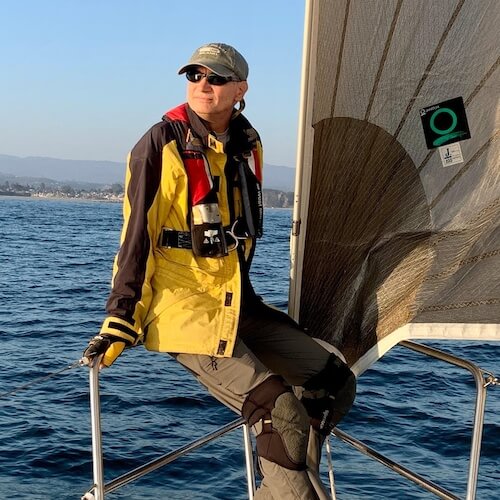

“It's time for my heart to be nurtured on one level yet contained on another. To go easy on me and to allow my feelings to be validated, not judged harshly. On the other hand, to let the heart rule with equanimity and not lead the mind and body around like a master.”
–Suzanne
“I spend time thinking of everything I am grateful for, and I try to develop my ability to express compassion for myself and others without reservation. I take time to do the things I need to do to keep myself healthy and happy. This includes taking experiential workshops, fostering relationships, and participating within groups which have a similar interest to become a more compassionate and fulfilled being.“
–Peter
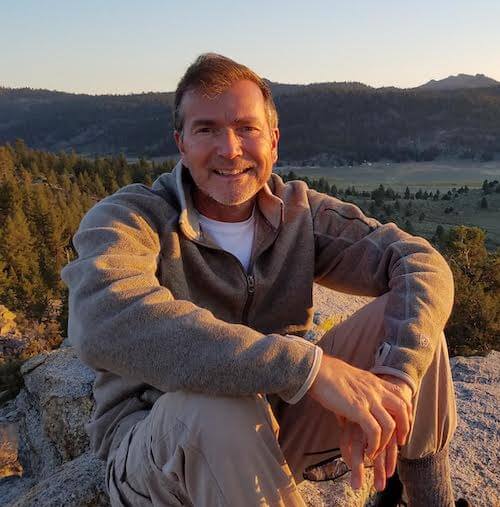
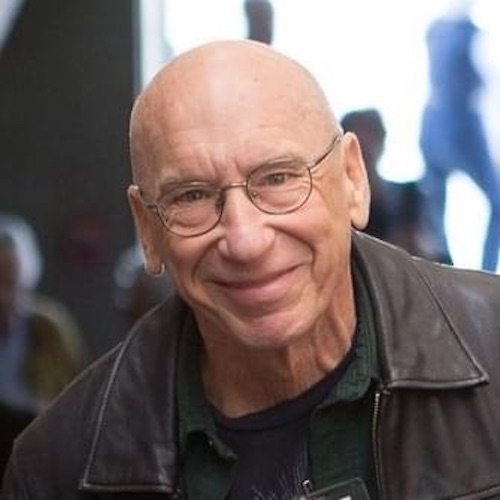
“Self-forgiveness for my own judgments. And oh yeah, coming to Esalen.”
–David B.
“Hmm, this is a tough one! I guess I take care of my heart through fostering relationships with people I feel connected to. Spending quality time with them (whether we're on the phone, through messages/letters, on Zoom, or in-person). Being there for them, listening to them, sharing what's going on with me, my struggles and my successes... like we do in the Esalen weekly Friends of Esalen Zoom sessions!”
–Lori

“I remind myself in many ways of the fact that " Love is all there is!" LOVE is the prize and this one precious life is the stage we get to learn our lessons. I get out into nature, hike, camp, river kayak, fly fish, garden, I create, I dance (not enough!), and I remain grateful for each day, each breath, each moment. Being in the moment, awake, and remembering the gift of life and my feeling of gratitude for all of creation.”
–Steven
“My physical heart by limiting stress and eating a heart-healthy diet. My emotional heart by staying in love with the world and by knowing that all disappointment and loss will pass.“
–David Z.
Today, September 29, is World Heart Day. Strike up a conversation with your own heart and as you feel comfortable, encourage others to do the same. As part of our own transformations and self-care, we sometimes ask for others to illuminate and enliven our hearts or speak our love language.
What if we could do this for ourselves too, even if just for today… or to start a heart practice, forever?

Throughout history, bridges have connected two points and often served as a symbolic marker. A journey from here to there; a time to reflect along the way. This month, as Esalen unveils a new bridge connecting the north and south side of campus, faculty and staff reflect upon what bridges mean to them, the transformational process of creating a new bridge and the positive ripple effects the new structure will create.
Beloved Esalen faculty Chungliang Al Huang, a longtime tai chi teacher and the founder and president of the Living Tao Foundation, has a deep connection to the existing creek footbridge. He has crossed the bridge and meditated underneath it along the running brook for more than a half a century.
“Since I first came to teach here, that sacred place at the bridge represented my life’s work in bridging East/West cultural arts and finding a synthesis of the world’s yin/yang ‘tai ji’ unity,” Al says. “From the early days when Esalen co-founder Dick Price and I shared our kinship of being the perennial students immersed in the Tao, we treaded the path under that special bridge into the ravine and canyon hundreds of times together. It holds significant meaning for me.”
The current bridge was built in the mid-1980s. The genesis of the new bridge emerged as a way to create better access for all between the two sides of the Esalen campus, which a fresh water creek bisects. “The current bridge was at the end of its usable life," says Esalen Special Projects Manager Bruce Christiansen. "While the bridge may have meet the safety standards of the time it was built, there was room for improvement."
The new bridge features a variety of improvements, including:
From groundbreaking to completion, the construction process took approximately six months. Staff worked with a biologist throughout the bridge’s planning and execution, taking into consideration any and all environmental concerns.
The end result features a 50-foot span across the creek that is 12 feet wide with improved approaches and drainage on both sides. The structure contains a composite beam design consisting of steel I-beams with a reinforced concrete deck and a wooden and metal railing. Material from the old bridge will be distributed throughout the greater community.
"I see the symbolism in the new bridge as we're building a bridge between the old and the new, the past and the future," Bruce says.
"The old foot bridge carried a great many feet, human and beast, and provided as many intimate moments as those feet moved past each other," adds Tim Hulls, Esalen’s Director of Facilities. "The new bridge is a major milestone toward progress and what we at Esalen need to do to provide an experience that is inclusive, safe and a movement to sustainable practices."
Over the decades, many seminarians have experienced the Esalen bridge and have appreciated its placement on campus, including staff who have worked on property for many years.
"For me, the bridge always symbolized 'connection' as it connects both sides of the campus," says Tatyana Sanikovich, Esalen's Director of Human Resources. "I was taught a ritual while crossing the bridge that I enjoy. I was taught to stand on the bridge over the creek while facing the ocean. Next, you close your eyes and think of everything that you want to let go of that does not serve you, and you release it down the stream to the ocean. Then you turn to the canyon and think of everything you want to invite into your life and voice it internally or speak it out loud. As you face the river it will flow into you and your life. And then I would cross the bridge whichever direction I needed to go."
Al echoes Tatyana's sentiments, noting that the bridge evokes a sense of wonder as he recalls many individuals associated with Esalen who have made a difference in his life.
"I think of the bridge — the crossing and coming together of two sides of Esalen — to be my kinship and fortuitous collaborations with Esalen mentors, such as Alan W. Watts, Joseph Campbell, Gregory Bateson, Laura Huxley [wife of Aldous Huxley], Stanislav Grof and Huston Smith,” Al says. “It has been my good fortune to be an integral part of the Esalen family and to continue sharing my belief of this world unity with the importance of East/West cultural arts synthesis. Jointly, we will prevail and wake up the world to realize this 'human potentiality' of peace on Earth through this blessed experience of a utopian living community—Esalen— in which we are blessed to belong and to thrive.”

“Remembering to be as self compassionate as I can and praying to the divine that we're all a part of.”
–Aaron
“Prayer, reading, meditation, walking.”
–Karen
“Erratically — which is an ongoing stream of practice to find peace.”
–Charles
“Try on a daily basis to be kind to myself and to realize that making mistakes is a part of the human condition. Learning from our mistakes is a journey. But it starts with compassion and caring. First for oneself.”
–Steve
“Physically: aerobic exercise, volleyball, ice hockey, cycling, sailing. Emotionally: unfortunately I have to work to ‘not care’ about people or situations which may end painfully. Along the lines of ‘attachment is the source of suffering’, so best to avoid it or limit its scope. Sad though because it could also be the source of great joy. Is it worth the risk?“
–Rainer


“It's time for my heart to be nurtured on one level yet contained on another. To go easy on me and to allow my feelings to be validated, not judged harshly. On the other hand, to let the heart rule with equanimity and not lead the mind and body around like a master.”
–Suzanne
“I spend time thinking of everything I am grateful for, and I try to develop my ability to express compassion for myself and others without reservation. I take time to do the things I need to do to keep myself healthy and happy. This includes taking experiential workshops, fostering relationships, and participating within groups which have a similar interest to become a more compassionate and fulfilled being.“
–Peter


“Self-forgiveness for my own judgments. And oh yeah, coming to Esalen.”
–David B.
“Hmm, this is a tough one! I guess I take care of my heart through fostering relationships with people I feel connected to. Spending quality time with them (whether we're on the phone, through messages/letters, on Zoom, or in-person). Being there for them, listening to them, sharing what's going on with me, my struggles and my successes... like we do in the Esalen weekly Friends of Esalen Zoom sessions!”
–Lori

“I remind myself in many ways of the fact that " Love is all there is!" LOVE is the prize and this one precious life is the stage we get to learn our lessons. I get out into nature, hike, camp, river kayak, fly fish, garden, I create, I dance (not enough!), and I remain grateful for each day, each breath, each moment. Being in the moment, awake, and remembering the gift of life and my feeling of gratitude for all of creation.”
–Steven
“My physical heart by limiting stress and eating a heart-healthy diet. My emotional heart by staying in love with the world and by knowing that all disappointment and loss will pass.“
–David Z.
Today, September 29, is World Heart Day. Strike up a conversation with your own heart and as you feel comfortable, encourage others to do the same. As part of our own transformations and self-care, we sometimes ask for others to illuminate and enliven our hearts or speak our love language.
What if we could do this for ourselves too, even if just for today… or to start a heart practice, forever?

Throughout history, bridges have connected two points and often served as a symbolic marker. A journey from here to there; a time to reflect along the way. This month, as Esalen unveils a new bridge connecting the north and south side of campus, faculty and staff reflect upon what bridges mean to them, the transformational process of creating a new bridge and the positive ripple effects the new structure will create.
Beloved Esalen faculty Chungliang Al Huang, a longtime tai chi teacher and the founder and president of the Living Tao Foundation, has a deep connection to the existing creek footbridge. He has crossed the bridge and meditated underneath it along the running brook for more than a half a century.
“Since I first came to teach here, that sacred place at the bridge represented my life’s work in bridging East/West cultural arts and finding a synthesis of the world’s yin/yang ‘tai ji’ unity,” Al says. “From the early days when Esalen co-founder Dick Price and I shared our kinship of being the perennial students immersed in the Tao, we treaded the path under that special bridge into the ravine and canyon hundreds of times together. It holds significant meaning for me.”
The current bridge was built in the mid-1980s. The genesis of the new bridge emerged as a way to create better access for all between the two sides of the Esalen campus, which a fresh water creek bisects. “The current bridge was at the end of its usable life," says Esalen Special Projects Manager Bruce Christiansen. "While the bridge may have meet the safety standards of the time it was built, there was room for improvement."
The new bridge features a variety of improvements, including:
From groundbreaking to completion, the construction process took approximately six months. Staff worked with a biologist throughout the bridge’s planning and execution, taking into consideration any and all environmental concerns.
The end result features a 50-foot span across the creek that is 12 feet wide with improved approaches and drainage on both sides. The structure contains a composite beam design consisting of steel I-beams with a reinforced concrete deck and a wooden and metal railing. Material from the old bridge will be distributed throughout the greater community.
"I see the symbolism in the new bridge as we're building a bridge between the old and the new, the past and the future," Bruce says.
"The old foot bridge carried a great many feet, human and beast, and provided as many intimate moments as those feet moved past each other," adds Tim Hulls, Esalen’s Director of Facilities. "The new bridge is a major milestone toward progress and what we at Esalen need to do to provide an experience that is inclusive, safe and a movement to sustainable practices."
Over the decades, many seminarians have experienced the Esalen bridge and have appreciated its placement on campus, including staff who have worked on property for many years.
"For me, the bridge always symbolized 'connection' as it connects both sides of the campus," says Tatyana Sanikovich, Esalen's Director of Human Resources. "I was taught a ritual while crossing the bridge that I enjoy. I was taught to stand on the bridge over the creek while facing the ocean. Next, you close your eyes and think of everything that you want to let go of that does not serve you, and you release it down the stream to the ocean. Then you turn to the canyon and think of everything you want to invite into your life and voice it internally or speak it out loud. As you face the river it will flow into you and your life. And then I would cross the bridge whichever direction I needed to go."
Al echoes Tatyana's sentiments, noting that the bridge evokes a sense of wonder as he recalls many individuals associated with Esalen who have made a difference in his life.
"I think of the bridge — the crossing and coming together of two sides of Esalen — to be my kinship and fortuitous collaborations with Esalen mentors, such as Alan W. Watts, Joseph Campbell, Gregory Bateson, Laura Huxley [wife of Aldous Huxley], Stanislav Grof and Huston Smith,” Al says. “It has been my good fortune to be an integral part of the Esalen family and to continue sharing my belief of this world unity with the importance of East/West cultural arts synthesis. Jointly, we will prevail and wake up the world to realize this 'human potentiality' of peace on Earth through this blessed experience of a utopian living community—Esalen— in which we are blessed to belong and to thrive.”

“Remembering to be as self compassionate as I can and praying to the divine that we're all a part of.”
–Aaron
“Prayer, reading, meditation, walking.”
–Karen
“Erratically — which is an ongoing stream of practice to find peace.”
–Charles
“Try on a daily basis to be kind to myself and to realize that making mistakes is a part of the human condition. Learning from our mistakes is a journey. But it starts with compassion and caring. First for oneself.”
–Steve
“Physically: aerobic exercise, volleyball, ice hockey, cycling, sailing. Emotionally: unfortunately I have to work to ‘not care’ about people or situations which may end painfully. Along the lines of ‘attachment is the source of suffering’, so best to avoid it or limit its scope. Sad though because it could also be the source of great joy. Is it worth the risk?“
–Rainer


“It's time for my heart to be nurtured on one level yet contained on another. To go easy on me and to allow my feelings to be validated, not judged harshly. On the other hand, to let the heart rule with equanimity and not lead the mind and body around like a master.”
–Suzanne
“I spend time thinking of everything I am grateful for, and I try to develop my ability to express compassion for myself and others without reservation. I take time to do the things I need to do to keep myself healthy and happy. This includes taking experiential workshops, fostering relationships, and participating within groups which have a similar interest to become a more compassionate and fulfilled being.“
–Peter


“Self-forgiveness for my own judgments. And oh yeah, coming to Esalen.”
–David B.
“Hmm, this is a tough one! I guess I take care of my heart through fostering relationships with people I feel connected to. Spending quality time with them (whether we're on the phone, through messages/letters, on Zoom, or in-person). Being there for them, listening to them, sharing what's going on with me, my struggles and my successes... like we do in the Esalen weekly Friends of Esalen Zoom sessions!”
–Lori

“I remind myself in many ways of the fact that " Love is all there is!" LOVE is the prize and this one precious life is the stage we get to learn our lessons. I get out into nature, hike, camp, river kayak, fly fish, garden, I create, I dance (not enough!), and I remain grateful for each day, each breath, each moment. Being in the moment, awake, and remembering the gift of life and my feeling of gratitude for all of creation.”
–Steven
“My physical heart by limiting stress and eating a heart-healthy diet. My emotional heart by staying in love with the world and by knowing that all disappointment and loss will pass.“
–David Z.
Today, September 29, is World Heart Day. Strike up a conversation with your own heart and as you feel comfortable, encourage others to do the same. As part of our own transformations and self-care, we sometimes ask for others to illuminate and enliven our hearts or speak our love language.
What if we could do this for ourselves too, even if just for today… or to start a heart practice, forever?